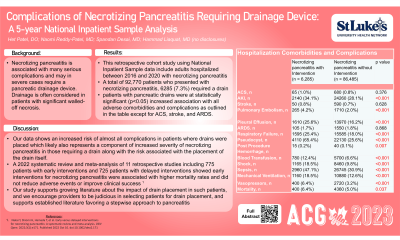Sunday Poster Session
Category: Biliary/Pancreas
P0020 - Complications of Necrotizing Pancreatic Requiring Drainage Device: A 5-Year National Inpatient Sample Analysis
Sunday, October 22, 2023
3:30 PM - 7:00 PM PT
Location: Exhibit Hall

Has Audio

Het Patel, DO
St. Luke's University Health Network
Bethlehem, PA
Presenting Author(s)
Het Patel, DO1, Naomi Reddy-Patel, MD2, Spandan Desai, MD3, Hammad Liaquat, MD2
1St. Luke's University Health Network, Bethlehem, PA; 2St. Luke's University Health Network, Bethlehem, PA; 3St. Luke's University Health Network, Bethlehem, OR
Introduction: Necrotizing pancreatitis is associated with many serious complications and may in severe cases require a pancreatic drainage device. Drainage is often considered in patients with significant walled-off necrosis. The aim of this study is to assess the risk of inpatient complications in patients who have drainage devices placed for necrotizing pancreatitis by analyzing national data.
Methods: This is a retrospective cohort study using National Inpatient Sample data including adults hospitalized between 2016 and 2020 with necrotizing pancreatitis. The primary outcomes measured were inpatient complications in patients requiring pancreatic drain placed endoscopically, percutaneously, or via an open approach compared to patients without a drain placed. Statistical analyses were all performed using STATA software.
Results: Of the 92,770 patients who presented with necrotizing pancreatitis, 6285 (7.3%) required a drain, 67.0% of patients were White and 66.9% were males, and mean age 54.5 versus 50.6 in the non-intervention group. Patients with pancreatic drains were at statistically significant (p< 0.05) increased risk for AKI (OR=1.349; 95% Cl 1.197-1.520), pulmonary embolism (OR=2.210; 95% Cl 1.638-2.979), pleural effusion (OR=1.871; 95% CI 1.649-2.122), respiratory failure (OR=1.579; 95% CI 1.384-1.802), pseudocyst (OR=5.775; 95% CI 5.103-6.5 36), post procedure hemorrhage (OR=5.154; 95% CI 1.365-19.461), shock (OR=2.169; 95% CI 1.872-2.512), sepsis (OR=2.043; 95% CI 1.815-2.300), and mortality (OR=1.286; 95% CI 1.014- 1.630). These patients were at increased risk for requiring blood transfusion (OR=2.076; 95% CI 1.732-2.487), mechanical ventilation (OR=1.607; 95% CI 1.379-1.873), and vasopressors (OR=2.132; 95% CI 1.669-2.722). Patients with pancreatic drains did not have a statistically significant risk (p >0.05) of ARDS, acute coronary syndrome (ACS), and stroke.
Discussion: Our data shows an increased risk of almost all complications in patients where drains were placed. Drain placement has an inherit risk of complications and may impact outcomes in this patient population. Our data likely also represents a component of increased severity of necrotizing pancreatitis in those requiring a drain along with the risk associated with the placement of the drain itself. Our study supports growing literature about the impact of drain placement in such patients, and we encourage providers to be judicious in selecting patients for drain placement.
Disclosures:
Het Patel, DO1, Naomi Reddy-Patel, MD2, Spandan Desai, MD3, Hammad Liaquat, MD2. P0020 - Complications of Necrotizing Pancreatic Requiring Drainage Device: A 5-Year National Inpatient Sample Analysis, ACG 2023 Annual Scientific Meeting Abstracts. Vancouver, BC, Canada: American College of Gastroenterology.
1St. Luke's University Health Network, Bethlehem, PA; 2St. Luke's University Health Network, Bethlehem, PA; 3St. Luke's University Health Network, Bethlehem, OR
Introduction: Necrotizing pancreatitis is associated with many serious complications and may in severe cases require a pancreatic drainage device. Drainage is often considered in patients with significant walled-off necrosis. The aim of this study is to assess the risk of inpatient complications in patients who have drainage devices placed for necrotizing pancreatitis by analyzing national data.
Methods: This is a retrospective cohort study using National Inpatient Sample data including adults hospitalized between 2016 and 2020 with necrotizing pancreatitis. The primary outcomes measured were inpatient complications in patients requiring pancreatic drain placed endoscopically, percutaneously, or via an open approach compared to patients without a drain placed. Statistical analyses were all performed using STATA software.
Results: Of the 92,770 patients who presented with necrotizing pancreatitis, 6285 (7.3%) required a drain, 67.0% of patients were White and 66.9% were males, and mean age 54.5 versus 50.6 in the non-intervention group. Patients with pancreatic drains were at statistically significant (p< 0.05) increased risk for AKI (OR=1.349; 95% Cl 1.197-1.520), pulmonary embolism (OR=2.210; 95% Cl 1.638-2.979), pleural effusion (OR=1.871; 95% CI 1.649-2.122), respiratory failure (OR=1.579; 95% CI 1.384-1.802), pseudocyst (OR=5.775; 95% CI 5.103-6.5 36), post procedure hemorrhage (OR=5.154; 95% CI 1.365-19.461), shock (OR=2.169; 95% CI 1.872-2.512), sepsis (OR=2.043; 95% CI 1.815-2.300), and mortality (OR=1.286; 95% CI 1.014- 1.630). These patients were at increased risk for requiring blood transfusion (OR=2.076; 95% CI 1.732-2.487), mechanical ventilation (OR=1.607; 95% CI 1.379-1.873), and vasopressors (OR=2.132; 95% CI 1.669-2.722). Patients with pancreatic drains did not have a statistically significant risk (p >0.05) of ARDS, acute coronary syndrome (ACS), and stroke.
Discussion: Our data shows an increased risk of almost all complications in patients where drains were placed. Drain placement has an inherit risk of complications and may impact outcomes in this patient population. Our data likely also represents a component of increased severity of necrotizing pancreatitis in those requiring a drain along with the risk associated with the placement of the drain itself. Our study supports growing literature about the impact of drain placement in such patients, and we encourage providers to be judicious in selecting patients for drain placement.
Table: Patient demographics and hospitalization length of stay, cost, comorbidities, and complications in patients with pancreatic drainage devices placed versus not placed in patients with necrotizing pancreatitis.
Abbreviations: ACS = Acute Coronary Syndrome, AKI = Acute Kidney Injury, ARDS = Acute Respiratory Distress Syndrome
Abbreviations: ACS = Acute Coronary Syndrome, AKI = Acute Kidney Injury, ARDS = Acute Respiratory Distress Syndrome
Disclosures:
Het Patel indicated no relevant financial relationships.
Naomi Reddy-Patel indicated no relevant financial relationships.
Spandan Desai indicated no relevant financial relationships.
Hammad Liaquat indicated no relevant financial relationships.
Het Patel, DO1, Naomi Reddy-Patel, MD2, Spandan Desai, MD3, Hammad Liaquat, MD2. P0020 - Complications of Necrotizing Pancreatic Requiring Drainage Device: A 5-Year National Inpatient Sample Analysis, ACG 2023 Annual Scientific Meeting Abstracts. Vancouver, BC, Canada: American College of Gastroenterology.
